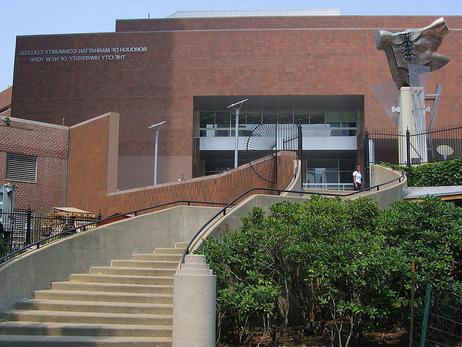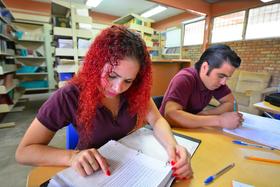In the remnants of the 9/11 terrorists attacks, few thought about one lone building from a local community college that was destroyed when the World Trade Center collapsed - except those who had come to call Borough of Manhattan Community College home. Over the next decade, the expanding college was forced to make other arrangements for holding classes – in the student cafeteria and temporary trailers set up in the vicinity of the original building. It was far from an ideal situation, with students reporting that the trailers didn’t always have working heat and served as a constant reminder of the terrible day when so many American lives were lost, including those of eight BMCC students and alumni.
But the school persevered.
This month, Borough of Manhattan Community College opened the doors of Fiterman Hall for the first time in more than 10 years. The beautiful new building is a reflection of light with windowed walls and a breathtaking lighted spiral staircase. It is a far cry from the smoke and debris that littered the area for so long. Now, students are preparing to take classes at Fiterman once again, in a brand new building designed just for them.
The Funding of Fiterman Hall
The day of the attacks, Fiterman Hall was damaged beyond repair. The building was finally razed in 2009, the year that reconstruction began, according to the community college’s website. Prior to razing, funding had to come in to pay for the project. The building also had to be deconstructed carefully, as renovations had been in the process at the time of the attacks, in part to remove extensive asbestos from the building.
Funding the new building was easier said than done, according to a report at the Wall Street Journal. There were conflicts with the insurance company, as well as arguments the Federal Emergency Management Agency, the agency that oversees college buildings. During that time, students had to walk past the 9/11 scene daily to attend classes in trailers set up near the site.
“It was a very demoralized area here around the World Trade Center,” G. Scott Anderson, vice president of administration and planning at BMCC, told the Wall Street Journal.
The school final received the funding they needed to rebuild, with $139 million coming from New York and additional money received from insurance settlements, the 9/11 fund and the Lower Manhattan Development Corporation. Community contributions also poured in for the new building, fueled by the efforts of Sheldon Silver, state assembly speaker for New York.
Groundbreaking Finally Begins
Groundbreaking for the new school began in 2009 after razing was complete. The school staged a groundbreaking ceremony to commemorate the process of moving forward from 9/11 and the many difficult years that followed for students and staff of the community college.
“In the weeks and months following September 11,” Antonio Perez, president of BMCC, stated on the college website during the groundbreaking ceremony, “BMCC drew strength from the unbreakable determination of its students and staff – and from an incredible outpouring of compassion and support from our friends and neighbors, here in New York and across the nation. The result: BMCC has come back stronger, bigger and better, with an enrollment today of over 21,000 degree students from some 155 countries and a richer, more diverse curriculum than ever before.”
Since the beginning of the construction of the new and improved Fiterman Hall, enrollment at BMCC has grown to 24,000. The community college was quite literally busting at the seams trying to find space for all of the classrooms it needed with its exponential growth in enrollment. Currently, BMCC has the largest student enrollment of undergraduates in the state of New York.
When the building was first destroyed, Perez said students began showing up shortly after to find out whether they would have classes to attend.
“We had students sneak through the blockades and barricades, showing up on campus wanting to know when they could return to class,” Perez told the Wall Street Journal.
The New Building Opens
Now, the students will get their reward for persevering through the difficulties and challenges of the past decade. The opening of the all-new Fiterman Hall will be a sight to behold, with a brand new glass faade handsomely framed by red brick, and a plethora of student amenities. According to the BMCC website, the building will include a caf overlooking a nearby park, a fine arts center, 80 smart classrooms and computer stations on every floor of the building. Other features include a wealth of computer labs and library space, music ensemble rooms and a rooftop conference center. Classes will begin at the new building at the start of this coming academic year.
Our students finally got the building they deserved,” Perez told the Wall Street Journal. “We’ve rebounded. We’ve been waiting for a long time to have it back.”
Memories Not Lost, but School Ready to Move Ahead
Each year, the school has a commemoration ceremony for the students and alumni of BMCC that lost their lives in the attacks. All eight had been in the towers when they were hit, including alumni of the school that were working as a fire fighter and an emergency medical technician. However, Perez said the focus of the school is to look ahead, not backward.
“After the attacks, we moved forward. And we never looked back,” Perez explained. “We were able to come back, rebound and provide something positive for our students.”













